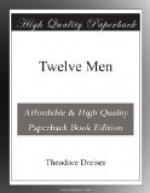“Oh, she’ll have me. I always tell her I’m going to marry her when she’s eighteen, and she says all right. And I really believe she does like me. I’m crazy about her.”
Five years later, if I may anticipate a bit, after he had moved to Newark and placed himself rather well in the journalistic field and was able to carry out his plans in regard to himself, he suddenly returned to Philadelphia and married, preparing beforehand an apartment which he fancied would please her. It was a fortunate marriage in so far as love and home pleasures were concerned. I never encountered a more delightful atmosphere.
All along in writing this I feel as though I were giving but the thinnest portrait of Peter; he was so full and varied in his moods and interests. To me he illustrated the joy that exists, on the one hand, in the common, the so-called homely and what some might think ugly side of life, certainly the very simple and ordinarily human aspect of things; on the other, in the sheer comfort and satisfaction that might be taken in things truly intellectual and artistic, but to which no great expense attached—old books, prints, things connected with history and science in their various forms, skill in matters relating to the applied arts and what not, such as the coloring and firing of pottery and glass, the making of baskets, hammocks and rugs, the carving of wood, the collection and imitation of Japanese and Chinese prints, the art of embalming as applied by the Egyptians (which, in connection with an undertaker to whom he had attached himself, he attempted to revive or at least play with, testing his skill for instance by embalming a dead cat or two after the Egyptian manner). In all of these lines he trained himself after a fashion and worked with skill, although invariably he insisted that he was little more than a bungler, a poor follower after the art of some one else. But most of all, at this time and later, he was interested in collecting things Japanese and Chinese: netsukes, inros, censors, images of jade and porcelain, teajars, vases, prints; and it was while he was in Philadelphia and seemingly trifling about with the group I have mentioned and making love to his little German girl that he was running here and there to this museum and that and laying the foundations of some of those interesting collections which later he was fond of showing his friends or interested collectors. By the time he had reached Newark, as chief cartoonist of the leading paper there, he was in possession of a complete Tokaido (the forty views on the road between Tokio and Kyoto), various prints by Hokusai, Sesshiu, Sojo; a collection of one hundred inros, all of fifty netsukes, all of thirty censers, lacquered boxes and teajars, and various other exceedingly beautiful and valuable things—Mandarin skirts and coats, among other things—which subsequently he sold or traded around among one collector friend and another for things which they had. I recall his selling his completed Tokaido, a labor which had extended over four years, for over a thousand dollars. Just before he died he was trading netsukes for inros and getting ready to sell all these latter to a man, who in turn was going to sell his collection to a museum.




